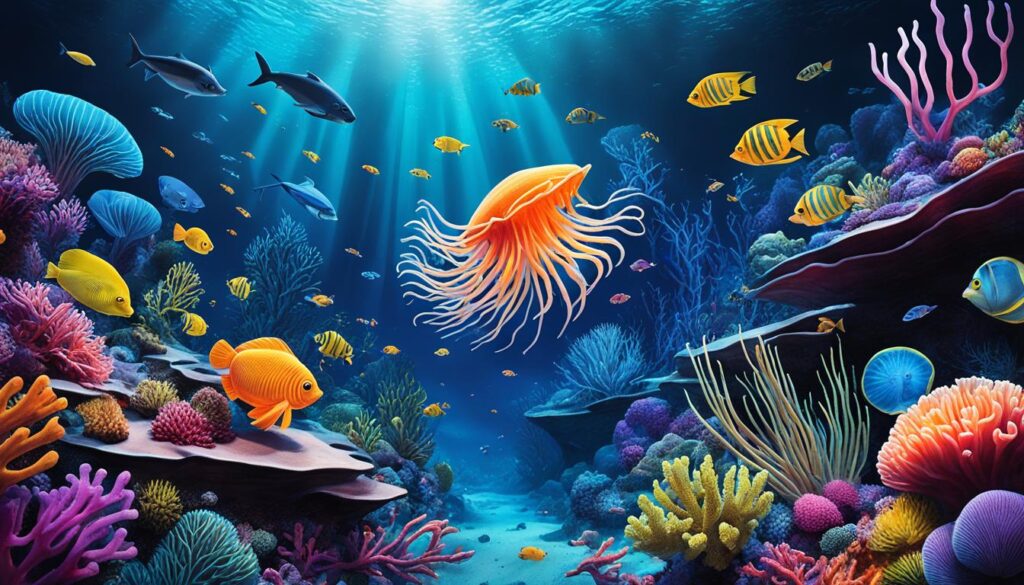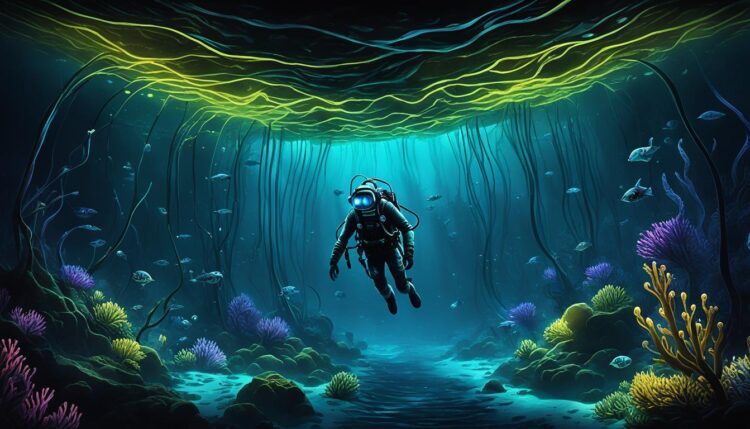The deep sea is a realm packed with intrigue and wonder. This expansive underwater world, stretching beyond the sunlit zone, is home to a myriad of oceanic mysteries and awe-inspiring marine ecosystems. The journey into the abyssal zone not only uncovers the enigma of bizarre life forms and unique geological formations, but also highlights the ecological importance of these underexplored habitats.
For centuries, the deep sea has captivated human curiosity. Today, advancements in technology have propelled deep-sea exploration, shedding light on the hidden treasures of the abyss. By understanding and appreciating the abyssal zone’s discoveries, we can better advocate for the preservation of these delicate marine ecosystems and their critical role in global ecology.
Key Takeaways
- The deep sea is an unexplored expanse filled with oceanic mysteries.
- Marine ecosystems in the abyssal zone host unique and enigmatic life forms.
- Technological advancements have enhanced deep-sea exploration efforts.
- Understanding the abyss aids in the conservation of these delicate ecosystems.
- The ecological significance of the deep sea is crucial for global sustainability.
Defining the Abyss: Understanding the Deep Sea
The abyssal zone, commonly referred to as the depths of the deep sea, is a realm shrouded in mystery and characterized by its unique and extreme environment. Inhabiting the depths between 3,000 and 6,000 meters, this zone plays a pivotal role in the comprehensive understanding of oceanic zonation and the Earth’s marine ecosystems.
The Characteristics of the Abyssal Zone
The defining abyssal zone characteristics include its perpetually dark environment, where sunlight fails to penetrate. This unbroken darkness hosts a variety of adapted marine species that have evolved to thrive under these conditions. Additionally, deep-sea conditions such as low temperatures hovering just above freezing and high-pressure environments significantly influence the biology and behavior of deep-sea organisms.
Zonation of the Deep Ocean
The deep sea is delineated into several distinct zones, each contributing to the ocean’s biodiversity. Layers include the mesopelagic, bathypelagic, and ultimately the abyssal, further extending into the hadal zone. This oceanic zonation significantly affects the distribution and adaptation of marine life, leading to unique ecosystems adapted to specific zones. Understanding these layers is crucial for grasping how oceanic environments function as a whole.
Pressure, Darkness, and Temperature Extremes
The abyssal zone epitomizes an environment of extremes. In these high-pressure environments, pressures can reach several tons per square inch, posing significant challenges to life forms. The constant deep-sea conditions of darkness demand extraordinary biological adaptations, such as bioluminescence. Extreme cold temperatures and the absence of sunlight necessitate specialized metabolic processes in abyssal organisms.
| Zone | Depth Range | Key Characteristics |
|---|---|---|
| Mesopelagic | 200 – 1,000 meters | Twilight zone, minimal light, presence of bioluminescent organisms |
| Bathypelagic | 1,000 – 4,000 meters | No light, high pressure, cold temperatures, adapted fauna |
| Abyssal | 4,000 – 6,000 meters | Perpetual darkness, high pressure, freezing temperatures |
| Hadal | 6,000+ meters | Deep ocean trenches, extreme pressure, specialized life forms |
The Enigma of the Abyss: Mysteries of the Deep
The abyss remains an enigma, teeming with enigmatic deep-sea life that continues to baffle scientists and researchers alike. From astonishing adaptations to geological mysteries, the deep sea harbors countless wonders waiting to be unveiled.
Bizarre Deep-sea Creatures
Among the most intriguing aspects of deep-sea exploration is the discovery of bizarre creatures that defy our understanding of life. The giant squid, or Architeuthis dux, is one such mesmerizing inhabitant, with its large, hypnotic eyes and lengthy appendages. Bioluminescent organisms, glowing with ethereal light, add a magical quality to the abyss, while extremeophiles around hydrothermal vents showcase life forms thriving in seemingly uninhabitable conditions. These enigmatic deep-sea life forms exhibit fascinating adaptations crucial for survival under the crushing pressures and perpetual darkness of the ocean’s depths.
Unique Geological Formations
Delving deeper into the geological mysteries, the deep sea reveals an array of unique geological formations. Undersea volcanoes and hydrothermal vents stand as testaments to the Earth’s dynamic nature and serve as hotspots for biological activity. These formations provide the foundations for thriving ecosystems, fostering a remarkable symbiosis between geology and biology. The interplay between these geological wonders and the enigmatic deep-sea life they support highlights the intricate and awe-inspiring tapestry of the abyss, emphasizing the importance of ongoing deep-sea exploration.
Deep-sea Exploration: A Human Obsession
The allure of the unknown has driven humanity to explore some of the most inhospitable environments on Earth. Deep-sea exploration has a rich history marked by incredible achievements and innovative breakthroughs.
Historical Pioneers in Deep-Sea Exploration
Throughout deep-sea exploration history, there have been notable deep-sea pioneers who have made significant contributions. William Beebe, a renowned zoologist, conducted some of the earliest deep-sea dives using a spherical submersible known as the Bathysphere. His work set the stage for future expeditions and heightened interest in the deep sea.
Furthering this legacy, Jacques Piccard and Don Walsh ventured into the Mariana Trench with the bathyscaphe Trieste in 1960, reaching unprecedented depths and expanding human understanding of the ocean’s mysteries. These trailblazers not only made remarkable discoveries but also inspired future generations of marine researchers.
Modern Technological Advancement in Exploration
Today, technological advancements have revolutionized deep-sea exploration. Remotely Operated Vehicles (ROVs) and Autonomous Underwater Vehicles (AUVs) are at the forefront of marine research innovation, allowing scientists to explore oceanic depths with unparalleled precision. These sophisticated machines are equipped with advanced sensors and high-definition cameras, providing invaluable data to researchers.
Modern technology has accelerated the pace of discovery within deep-sea ecosystems. For instance, ROV Jason, operated by the Woods Hole Oceanographic Institution, has been instrumental in documenting previously unseen species and unique ecological interactions. The advancements in submersible technology have turned once-impossible dreams into tangible realities, broadening our understanding of the deep-sea realm.
In summation, the combined efforts of historical deep-sea pioneers and contemporary technological advancements have unveiled the wonders of the ocean depths, making significant strides in marine research innovation.
Hydrothermal Vents: Life in Extreme Conditions
The discovery of hydrothermal vents has revolutionized our understanding of life’s resilience. These deep-sea marvels host unique ecosystems thriving in extreme conditions. They serve as living proof of life’s persistence in the abyss.
Discovery and Significance of Hydrothermal Vents
The hydrothermal vents discovery in the late 1970s unveiled an extraordinary world deep beneath the ocean’s surface. Located primarily along mid-ocean ridges, these vents spew heated, mineral-rich water. This phenomenon has significantly altered our perception of marine ecosystems and geological processes, offering essential insights into biogeochemical cycles and the fascinating dynamics of deep-sea biodiversity.
Hydrothermal vents support a wealth of marine extremophiles and have become focal points for scientific research, emphasizing their immense biological and geological importance. They function as natural laboratories, helping researchers understand the adaptability of life under extreme conditions.
Unique Ecosystems and Extremophiles
The ecosystems surrounding hydrothermal vents are home to various extremophile ecosystems, populated by organisms known as marine extremophiles. These creatures thrive in extreme conditions, including high temperatures and pressures, complete darkness, and toxic chemical surroundings. Key inhabitants include:
- Tubeworms
- Giant clams
- Various species of crabs and shrimp
- Thermophilic bacteria
These extremophile ecosystems are not only fascinating due to their unique adaptations but also contribute significantly to deep-sea biodiversity. The interactions within these ecosystems showcase a delicate balance, crucial for maintaining the health of our planet’s deepest habitats.
Deep-Sea Trenches: The Ocean’s Most Mysterious Places
Diving into the inky depths of the ocean reveals deep-sea trenches, spectacular features hidden far below the ocean’s surface. These trenches, including the renowned Mariana Trench and the Challenger Deep, are awe-inspiring in their depth and the mysteries they hold. Let’s explore.
Famous Deep-Sea Trenches
Among the most notable deep-sea trenches, the Mariana Trench stands out as the deepest. Located in the western Pacific Ocean, the trench reaches a staggering depth of nearly 36,000 feet. Within the Mariana Trench lies the Challenger Deep, the deepest known point of the Earth’s seabed. These trenches, part of a group known as oceanic trenches, are extremely challenging to access, making them some of the least explored regions on our planet.
Geological and Biological Significance of Trenches
Geologically, deep-sea trenches are formed by the process of subduction, where one tectonic plate slides beneath another, creating these profound underwater valleys. This process is crucial for understanding Earth’s geological activity and history. The biological significance of these trenches is equally compelling. Despite the extreme conditions, they host unique ecosystems that adapt to the intense pressure and darkness. Organisms dwelling in these depths exhibit extraordinary adaptations, providing insights into the resilience of life.
- Mariana Trench
- Challenger Deep
- Tonga Trench
- Philippine Trench
- Kermadec Trench
These oceanic trenches not only serve as windows into Earth’s geologic processes but also as vital repositories of biological diversity. By studying these trenches, scientists can unravel the mysteries of deep-sea adaptation and enhance our understanding of life’s boundaries.
| Trench Name | Max Depth (feet) | Notable Features |
|---|---|---|
| Mariana Trench | ~36,000 | Home to Challenger Deep |
| Tonga Trench | ~35,700 | Intense seismic activity |
| Philippine Trench | ~34,580 | Part of the western Pacific system |
| Kermadec Trench | ~32,963 | High seismicity |
The Biodiversity of the Abyss: A Hidden Paradise
Beneath the seemingly desolate abyss lies a thriving treasure trove of *marine biodiversity*. The abyssal zone, often perceived as inhospitable, is an *ecological marvel* brimming with life. From unique flora to enigmatic fauna, the array of *deep ocean species* is nothing short of astonishing. These organisms have adapted to survive in extreme conditions, navigating the darkness and pressure with remarkable resilience.

The richness of *abyssal biodiversity* highlights the importance of this enigmatic paradise. Deep-sea creatures, such as the bioluminescent jellyfish and the ghostly deep-sea octopus, illustrate the incredible adaptations of life that defy environmental constraints. Not merely surviving, these species play vital roles in their ecosystems, contributing to the broader *marine biodiversity* that maintains oceanic health.
This hidden paradise challenges our understanding of life’s limits, urging a deeper exploration of the abyss. By spotlighting the ecological importance of the abyssal zone, we underscore the necessity for its conservation. It is essential to recognize the abyss not as a lifeless void but as a vibrant community of *deep ocean species* that thrive in the planet’s final frontier.
| Organism | Unique Adaptation |
|---|---|
| Bioluminescent Jellyfish | Emits light to attract prey |
| Deep-Sea Octopus | Transparent body to avoid predators |
The *abyssal biodiversity* is a testament to nature’s ingenuity, showcasing life forms that are both fragile and resilient. Each species, with its unique traits, contributes to the intricate web of life found in these depths, cementing the abyss as an *ecological marvel* that warrants both awe and protection.
Impact of Human Activities on the Deep Sea
The deep sea, despite its remoteness, faces significant threats from various human activities. These activities are altering the delicate ecosystems that thrive in these dark, pressure-laden environments.
Pollution and Overfishing
One of the most pressing problems is deep-sea pollution, including the accumulation of microplastics that devastate marine life. These contaminants not only harm organisms through ingestion but also disrupt natural processes key to the ocean’s health. Overfishing impact has further stressed these ecosystems, leading to declining populations of species such as the Patagonian toothfish. Intensive fishing practices also damage habitats, making recovery challenging.
Effects of Climate Change
The climate change effects on the deep sea are multifaceted, affecting everything from temperature to ocean chemistry. Rising temperatures and ocean acidification, driven by increased CO2 levels, threaten the survival of coral reefs and other calcium-dependent organisms. Climate change also exacerbates the frequency and intensity of coral bleaching events, undermining the stability of vibrant underwater ecosystems.
Deep-Sea Mining Threats
The newest looming threat is deep-sea mining. As interest in mining resources like polymetallic nodules grows, the risks to marine environments become more pronounced. Deep-sea mining risks include habitat destruction, sediment plumes that suffocate marine life, and the potential for long-term ecological damage. As these ventures are still in their infancy, the full extent of their impact remains uncertain, but early indicators suggest significant threats to biodiversity and ecosystem functionality.
Tackling these complex issues requires a concerted effort to balance human interests with the preservation of our planet’s most enigmatic habitats.
Preservation Efforts: Conserving the Deep Sea
The deep sea is a fragile environment teeming with life and unique ecosystems. Given its importance, efforts to preserve these underwater habitats are paramount. Several strategies have been implemented globally to ensure the protection of the deep sea.
Marine Protected Areas (MPAs)
Marine Protected Areas (MPAs) are designated zones where human activity is restricted to safeguard aquatic ecosystems. These protected marine areas provide a refuge for endangered species and help maintain biodiversity. By limiting activities like fishing, drilling, and mining, MPAs assist in marine conservation and promote sustainable use of ocean resources. Numerous countries have established MPAs to mitigate human impact and encourage ecological recovery.
International Agreements and Policies
International agreements and policies play a critical role in deep-sea conservation. The United Nations Convention on the Law of the Sea (UNCLOS) serves as the overarching framework for governing maritime rights and responsibilities. This international sea law mandates the conservation and sustainable use of ocean resources, delineates boundaries for marine jurisdictions, and prescribes measures for protecting the marine environment. Such agreements underscore the collective responsibility of nations in conserving the deep sea’s biodiversity.
Role of Organizations in Conservation
Numerous organizations are at the forefront of advocating for deep-sea conservation policies. Bodies like the International Union for Conservation of Nature (IUCN) and the Marine Conservation Institute work tirelessly to promote the establishment of MPAs and influence international sea law. Through research, policy development, and public awareness campaigns, these organizations strive to ensure that marine conservation remains a priority for global governance. Their efforts highlight the indispensability of coordinated action in preserving the deep sea for future generations.
Conclusion
As we conclude our profound journey into the abyss, it becomes clear that the deep sea holds an unparalleled intrinsic value for both humanity and the natural world. Through the expanse of our exploration, we’ve unveiled a remarkable universe teeming with bizarre creatures, unique geological formations, and ecosystems that challenge our understanding of life’s resilience. The enigma of the abyss, with its mysteries and extremities, underscores the importance of deep-sea preservation.
While the wonders of the deep sea inspire awe, they are equally matched by the challenges faced in abyss exploration. Historical pioneers and modern advancements have collectively bridged the gap between the unknown and the known, pushing the boundaries of human curiosity. Nevertheless, the threats posed by pollution, overfishing, and climate change necessitate urgent and sustained efforts to protect these fragile environments. Hence, the future of ocean exploration must be geared towards sustainability and the protection of this vast, largely unexplored frontier.
Looking ahead, the importance of ongoing research and international cooperation cannot be overstated. As guardians of Earth’s most awe-inspiring ecosystems, it is our collective responsibility to ensure the deep-sea health for generations to come. Preserving these natural treasures not only enhances our scientific knowledge but also fortifies our planet’s long-term well-being. Thus, with a blend of curiosity and commitment, we champion deep-sea preservation and encourage a future of ocean exploration that prioritizes stewardship and reverence for these underwater realms.
FAQ
What defines the abyssal zone?
How is the deep ocean zoned?
What adaptations help deep-sea creatures survive?
Who are some key figures in deep-sea exploration history?
What modern technologies are used in deep-sea exploration?
Why are hydrothermal vents important?
What makes deep-sea trenches significant?
How does human activity impact the deep sea?
What are Marine Protected Areas (MPAs) and why are they important?
How can we help conserve the deep sea?
Source Links
- https://medium.com/@JohnJohnson83/journey-into-the-unknown-exploring-the-mysteries-of-the-deep-sea-f544a9140387
- https://medium.com/@abubakargrw1122/descending-into-the-abyss-unraveling-the-mysteries-of-the-deep-sea-cf5e4347bf21
- https://www.abyss.com.au/en/blog/viewpost/452/exploring-the-abyss-unveiling-the-mysteries-of-the-deep











